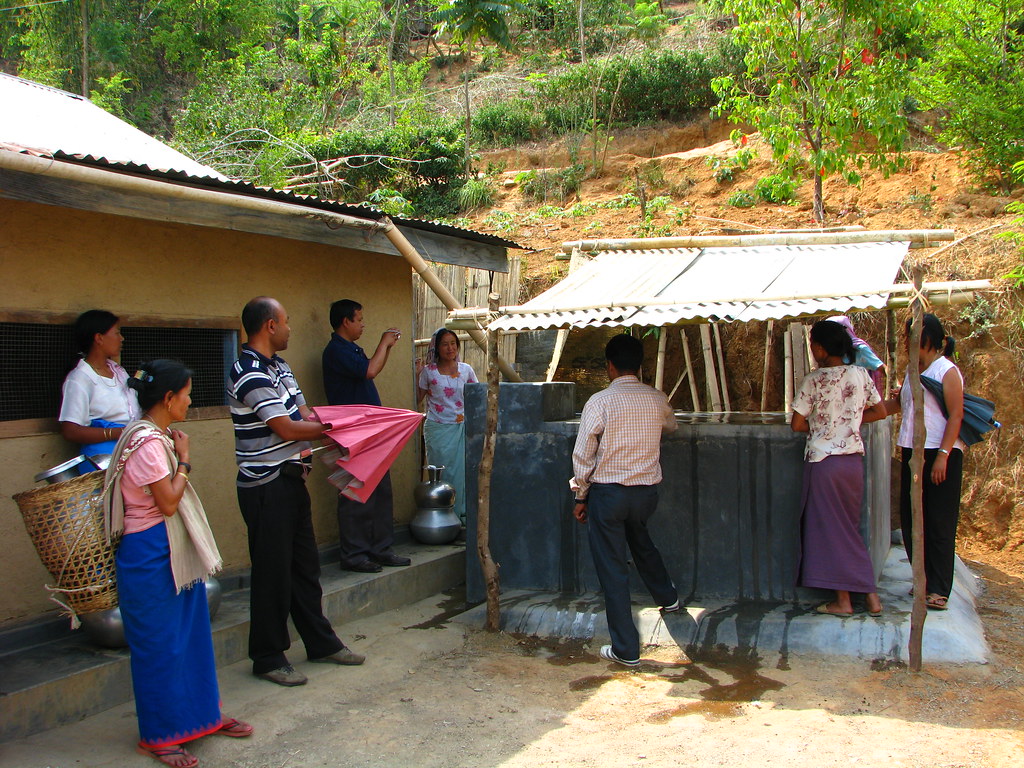In a world where sustainability and environmental consciousness reign supreme, there is a growing demand for innovative and efficient solutions to conserve water. While most of us rely heavily on the public water supply or underground wells, have you ever stopped to think about the bountiful resource that falls right from the sky? Yes, we’re talking about rainwater – the untapped potential that holds the key to a greener future.
In this article, we delve into the fascinating world of rainwater harvesting and discuss how to implement a system to collect this precious fluid. Through a creative lens, we’ll navigate you through the intricacies of designing a rainwater collection system that not only saves water but also minimizes your environmental footprint. So, whether you’re a passionate eco-warrior or simply someone looking to reduce their water bills, stay tuned as we uncover the secrets of harnessing rainwater for a sustainable tomorrow.
1. Sustainable Solutions: Implementing an Effective Rainwater Harvesting System
Implementing an effective rainwater harvesting system is not only a sustainable solution, but it can also save you money and help conserve water. By collecting and storing rainwater, you can reduce your reliance on traditional water sources, such as municipal water supplies, which often come with high costs and environmental impacts. But how can you effectively put a rainwater harvesting system in place?
Here are a few steps to guide you:
- Assess your water needs: Before implementing a rainwater harvesting system, it’s important to determine your water requirements. Consider factors such as the size of your household, your gardening needs, and any other water-consuming activities. This assessment will help you determine the size and capacity of your harvesting system.
- Choose the right components: Selecting the appropriate components for your rainwater harvesting system is crucial for its effectiveness. Components such as rain barrels, gutters, downspouts, and filters will help capture and store rainwater efficiently, while also ensuring the water is free from debris and contaminants.
- Proper installation: Installing your system correctly is essential for optimal functionality. Whether you’re setting up a simple rain barrel or a more complex system with multiple collection points, ensure that all components are securely connected and positioned to maximize water collection.
- Maintenance: Regular maintenance of your rainwater harvesting system is necessary to keep it running smoothly. This may include cleaning filters, checking for leaks or damages, and ensuring proper drainage. By keeping your system well-maintained, you can ensure its longevity and efficiency.
By following these steps, you can successfully implement an effective rainwater harvesting system. Not only will you be contributing to sustainable water management, but you’ll also reap the benefits of cost savings and reduced environmental impact.

2. Key Considerations for Setting up a Rainwater Collection System
When it comes to setting up a rainwater collection system, there are a few key considerations that are essential to ensure a successful installation. Whether you are looking to reduce your water bill, conserve water for gardening, or simply take a step towards sustainability, these tips will help you make the most out of your rainwater collection efforts.
- Select the Right Storage Containers: Choosing the appropriate storage containers for your rainwater collection system is crucial. Consider factors such as the size, material, and durability of the containers. Additionally, make sure to select containers that are designed specifically for rainwater collection, ensuring proper filtration and prevent contamination.
- Optimize Your Collection Surfaces: To maximize the amount of rainwater you can collect, it’s important to have suitable collection surfaces. This can include rooftops, driveways, and even large open areas. Implementing gutter systems and downspouts can help direct rainwater directly into your storage containers, reducing the risk of runoff and ensuring efficient collection.
- Invest in Proper Filtration: It is vital to invest in a reliable filtration system to ensure the collected rainwater is clean and safe for various uses. This can include sediment filters, carbon filters, and UV sterilization systems. Regular maintenance and cleaning of the filtration system are also critical to maintain water quality.
Remember, setting up a rainwater collection system requires careful planning and consideration to achieve optimal results. By applying these key considerations, you can create a sustainable water source that benefits both the environment and your daily needs.

3. Designing and Sizing your Rainwater Catchment System: Best Practices and Guidelines
When it comes to designing and sizing your rainwater catchment system, there are several best practices and guidelines that can help ensure its effectiveness and efficiency. Consider these tips to set up a successful and sustainable water harvesting solution:
- Assess your needs: Start by determining the specific purposes for which you plan to use the collected rainwater. Whether it’s for irrigation, household use, or wildlife habitats, understanding your water requirements will enable you to design a system that meets your needs.
- Calculate your catchment area: Evaluate the size of your rooftop, as it plays a crucial role in determining the amount of rainwater you can harvest. Keep in mind that factors such as roof shape, slope, and material can affect water collection efficiency. Consider installing gutters and downspouts to channel rainwater into a storage system.
- Select an appropriate storage capacity: Depending on your usage and local rainfall patterns, choose a storage tank size that supports your water demands while considering the available space on your property. Aim to strike a balance between storage capacity and cost, ensuring that your system remains sustainable in the long run.
Additionally, it’s essential to pay attention to the design and installation of conveyance systems to ensure optimal water flow and minimize losses. Proper placement of filters, screens, and first flush diverters can help remove debris and contaminants, improving the quality of captured rainwater. Prioritize regular maintenance and inspection of your rainwater catchment system to identify and address any potential issues promptly.
Remember, designing and sizing a rainwater catchment system involves a consideration of various factors unique to your location and intended usage. By following these best practices and guidelines, you can create an efficient and sustainable solution that harnesses the power of rainwater for a range of purposes.

4. Ensuring Long-term Success: Maintenance and Monitoring of Rainwater Harvesting Infrastructure
When it comes to implementing a rainwater harvesting system, it is essential to establish a comprehensive maintenance and monitoring plan to ensure its long-term success. Proactive management of the infrastructure is crucial to optimize water collection, prevent potential issues, and promote sustainability. Here are some key considerations for effectively maintaining and monitoring your rainwater harvesting system:
- Regular Inspections: Conduct routine inspections of all components, such as gutters, downspouts, storage tanks, and filtration systems. Identify any signs of damage, blockages, or leaks that may affect the efficiency of water collection.
- Keep it Clean: Regularly clean all system components, including gutters and filters, to prevent debris buildup. Clearing out accumulated leaves, branches, or other obstructions is vital to maintain proper flow and prevent clogging.
- Monitor Water Quality: Test the collected rainwater periodically to ensure its suitability for intended uses. Check for potential contamination sources, such as nearby pollutants or animal droppings. This proactive approach helps ensure the safety and usability of the harvested water.
Furthermore, it is crucial to establish a schedule for regular maintenance tasks, such as tank cleaning, filter replacement, and overall system check-ups. Keep detailed records of all maintenance activities and their outcomes to monitor the performance of the rainwater harvesting infrastructure. By proactively managing and monitoring your system, you can prolong its lifespan, optimize water collection efficiency, and contribute to a sustainable water supply for your needs.
In conclusion, implementing a rainwater collection system is more than just a practical solution to alleviate the scarcity of water resources. It is a transformative approach that harmonizes human ingenuity with the beauty of nature. By capturing and utilizing the gift of rain, we not only contribute to our own self-sustainability but also establish a profound connection with the environment around us.
Imagine a world where every drop of rain that falls from the heavens is cherished, collected, and valued. A world where rooftops become canvases for innovation, seamlessly integrating advanced technologies with nature’s age-old wisdom. As we embark on this journey, we open doors to a future that renews its commitment to preservation and conservation.
With every raindrop we harvest, we foster a sense of responsibility towards safeguarding our planet for generations to come. Rainwater becomes a symbol of hope, cascading down as a reminder that our efforts, no matter how small, can create ripples of change. From rooftops to gardens, from rural communities to bustling cities, this movement transcends boundaries and unites us in a shared vision for a sustainable future.
Let us rise above the limitations of old-fashioned practices and embrace the untapped potential that lies within rainwater. Let us celebrate simplicity and efficiency, recognizing that the solution to our water challenges might be right above our heads. By harnessing the power of rain, we can redefine the contours of water management and become pioneers in the pursuit of a greener, more resilient world.
So, as we close this chapter on implementing a rainwater collection system, let us remember that the seeds we sow today will grow into an abundant tomorrow. Let us take the first step towards a future where raindrops are treasured, not wasted. And in doing so, let us leave a lasting legacy of environmental stewardship for generations to come. Together, with every drop we save, we create a ripple of change that can transform our world. Let the rainwater collection system be a testament to our commitment, innovation, and unwavering dedication to building a brighter, more sustainable future.




